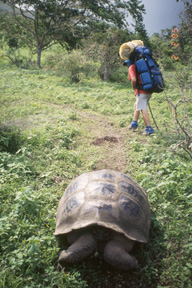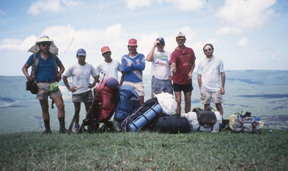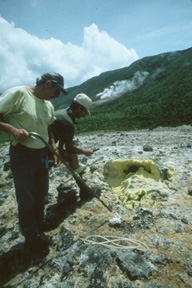
A Galapágos tortoise observes Jim Stimac backpacking to the rim of Alcedo caldera. All photos courtesy of Fraser Goff.
Isabela, the largest island, consists of six coalesced basaltic shields resembling upside-down soup bowls 30 to 60 kilometers across and more than one kilometer high. Two of these shields, Sierra Negra and Alcedo, are noted for their vigorous fumarolic activity. We were the first to sample for tritium in the Galápagos and also the first to determine if the fumaroles were volcanic or geothermal. Although sampling the gases of these fumaroles was our main objective, our trip became a goat-eating, burro-sacrificing, volcano-exploring adventure.
The Galápagos islands are remote and their special ecology, geology and history are preserved as an Ecuadorian national park. The climate is hot, people are scarce and drinking water is scarcer. While most tourists stay within one or two kilometers of the ocean, my colleagues Gary M. McMurtry of the University of Hawaii, Alfredo Roldán-Manzo of Instituto Nacional de Energia in Guatemala and then post-doc Jim A. Stimac of Los Alamos and I planned to camp on the caldera rims and make day trips to intracaldera sites.

